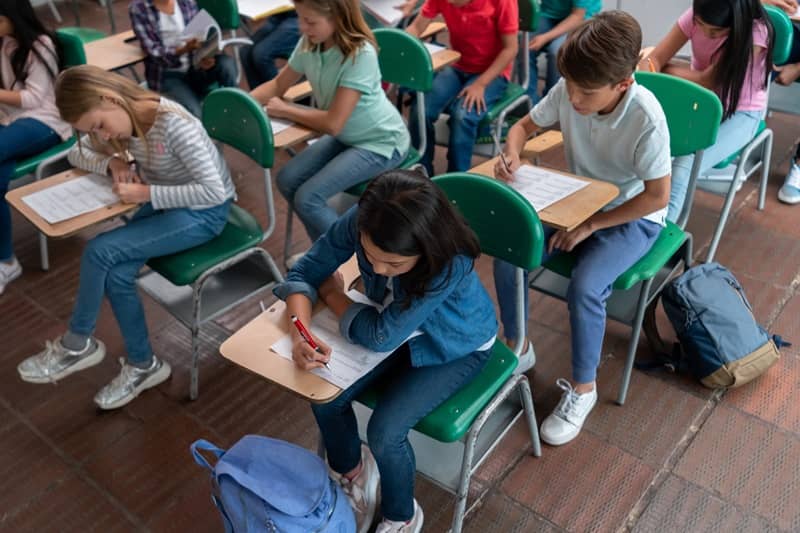By Eric Fruits, Ph.D.
Critics of education savings accounts, or ESAs, claim ESA programs “defund” public schools. In particular, they fear that an ESA program would reduce local public education spending. Contrary to these fears, school choice programs such as ESAs do not “defund” public schools. Instead, school choice programs simultaneously reduce costs to public schools and increase per-student funding.
Since 2015, the Oregon Legislature has considered several concepts to introduce ESAs. ESAs allow parents to withdraw their children from public district or charter schools and receive a deposit of public funds into government-authorized savings accounts with restricted, but multiple, uses. Those funds can be used to cover private school tuition and fees, online learning programs, private tutoring, community college costs, higher education expenses, and other approved customized learning services and materials.
Since the COVID-19 pandemic, the number of states offering ESAs has doubled from four states to eight. Because of the widespread popularity of ESAs and other parental choice programs, 2021 was widely recognized as the “Year of School Choice.” In 2022, Arizona expanded its “Empowerment Scholarship Accounts” program to all children, creating the country’s first “universal” ESA program.
Critics of ESAs, such as teachers’ unions and local school district officials, often claim that ESA programs “defund” public schools throughout the state. This is because school district enrollment is a key factor determining how state money is distributed to districts. Critics claim that if ESAs caused a large-scale exodus from public schools, districts would be starved of the funds to operate. They also argue that even if a small number of students left a district, the loss of funds would result in diminished services for the children who chose to remain in those schools. For example, in a 2017 hearing before the Oregon Senate Committee on Education, State Senator Arnie Roblan—a former public school superintendent—noted, “Once the person leaves the school system, there isn’t any money for them any longer.”
There is a nugget of truth in this claim. Certainly, if a student moved from Beaverton School District to Hillsboro School District, Beaverton would lose state funding but Hillsboro would gain state funding from the change in enrollment. From the perspective of the state as a whole, state spending would remain unchanged—the money has moved from one district to another. No one seems to have a problem with families relocating and shifting funds from one public school district to another. In this sense, the underlying assumption is wrong because the money for the student is still there, but it’s in another district.
Under an ESA program, if a student left Beaverton public schools for a private school or homeschooling, the funding would shift from Beaverton to the private school or to support the family’s homeschooling expenses. From the perspective of the state as a whole, state spending would remain unchanged—the money has moved from a public school district to another schooling option. Just as in the example above, the money for the student is still there, but spent in another place.
Claims that an ESA program would cause a mass exodus from the public school system are simply wrong. In fact, there is no evidence that any ESA program in the U.S. has ever resulted in large-scale departures from public schools.[1] There is no evidence that an ESA program has caused the closure of any public school.
Moreover, critics who fear an ESA program would cause a massive departure from the public school system rarely identify why they have this fear. Is it because many families are unhappy with their children’s public schools and they are looking for opportunities to go elsewhere? If so, then they have supported the argument in favor of ESA programs.
Indeed, it may already be the case that parents are “voting with their feet” for other education options. Pre-pandemic, the Oregon Department of Education reported that 79% of the state’s school-aged population were attending public schools. The latest data indicate only 75% are enrolled in public schools. In other words, one-in-four Oregon children are currently getting their education outside the government-run school system.
Under the current education funding system, if a student left Beaverton public schools for a private or home school, Beaverton would lose that funding. But from the state’s perspective, the move saved Oregon money because the state no longer would be paying for that student’s schooling. If total state funding remained unchanged, then that “extra” money means per-student funding would increase for students remaining in public schools.
While the numbers vary widely from district to district, on average, Oregon schools get a little less than 55% of their funding from the state, about 40% from local sources, and around 6% from the federal government.
State money provided to school districts begins with the legislature, which allocates a “top-line” number for school and education service districts. In the most recent budgeting session, the Oregon Legislature appropriated $4.7 billion to school districts and education service districts (ESDs) for the 2022-23 school year. Over the past 10 years, state school funding has increased by 50%. Since the COVID-19 pandemic, Oregon public school enrollment has dropped by 5%, while state spending on public schools increased by 7%. As a result, per-student spending has increased by 13% from pre-pandemic levels.

The Oregon Department of Education runs the legislature’s top-line number through a complex set of calculations to determine how much money each district gets. A key determinant is “ADMw,” or weighted average daily membership. Average daily membership is the average number of students attending school each day throughout the school year, weighted by a variety of factors.[2] The $4.7 billion allocated by the legislature works out to about $6,900 per ADMw, or $8,400 per student. Adding $4,100 from local sources, per-student spending from state and local sources amounts to an average of $12,500 per student.
Local sources include property taxes, federal forest fees, and state timber revenues. None of these revenues depend on district enrollment; districts would receive the same amount of money if enrollment doubled, or if they had no students at all. Similarly, federal funds typically are based on multiple factors in addition to student enrollment, meaning that most federal funds would remain regardless of enrollment. That means if public school enrollment declined, most of the local and federal funds would remain. Because about 45% of funding comes from local and federal sources that are not tied to enrollment, lower enrollment would lead to higher per-student funding available to the remaining students. Moreover, smaller enrollment should reduce costs to public schools as they no longer would have to pay to educate the students who left.
Assume that an ESA program would cause 5% of a district’s students to leave the district for an education outside the public system. The tables below show the effects of the decreased enrollment on state and local funding and per-student funding. The tables represent a large district (Beaverton in Washington County), a mid-sized district (Dayton in Yamhill County), a small district (Stanfield in Umatilla County), and all districts combined.
In each example, the decline in enrollment would be associated with increased per-student funding for the remaining students in the public school system. Indeed, every district would see an increase in per-student funding. This is because every district has local funding for its public schools, and this funding does not depend on enrollment.
Contrary to critics’ concerns, school choice programs such as ESAs do not “defund” public schools. Instead, school choice programs simultaneously reduce costs to public schools and increase per-student funding.




[1] For example, Florida’s ESA program has the highest participation rate among all ESA programs in the U.S., and less than 5% of eligible students participate in the program.
[2] In Oregon, not all students are treated equally in the ADMw formula. Students who are in poverty, pregnant, foster children, or enrolled in English as a Second Language or special education programs get greater weighting. For example, a foster child in poverty and enrolled in an ESL program counts as two students under the ADMw formula. Because of this weighting, the ADMw reported by districts is always higher than actual enrollment.
Eric Fruits, Ph.D. is Vice President of Research at Cascade Policy Institute. He is also an adjunct economics professor at Portland State University.












